It's hard to believe that it's already Christmas again! Here are my picks for some great gifts and stocking stuffers for the musicians on your list this year. There's some general suggestions as well as some specific gear that I have really liked.
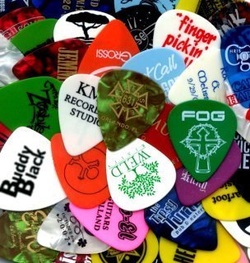 Custom Guitar Picks
How about some guitar picks with your guitarist's name on it? What about a picture of your guitarist? You can get custom guitar picks in any color, material, and size that you desire with any logo, picture, or text that you choose. There are a lot of places out there that do this (google: custom guitar picks), but they are a little pricey. The going rate seems to be around $50 for a few dozen custom guitar picks. Note that you will have to order these ASAP to get them for Christmas as they are custom made and most places get lots of Christmas orders!
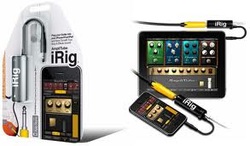 Amplitube iRig for iPhone/iPod/iPadAre you kidding me? This is one of the best ideas i've seen in a long time. If you have an iPhone or iPod Touch and you play guitar this should be on your list. You plug your guitar into iRig. One cable goes to the iPhone/iPod and the other goes to headphones. Just that concept alone is enough to sell me on this product. But it comes with Amplitube, one of the best guitar modeling software packages out there. I use a version of Amplitube for recording guitar at home. At around $40, this is a GREAT gift for your guitarist with an iPod Touch or iPhone.
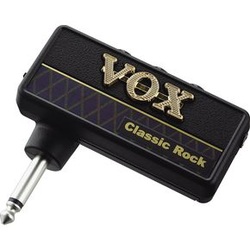 Vox AmplugA pocket-sized amp for about $40? Yes, please. The vox amplug gives great tone and features at a really cheap price. Throw this in your guitar case with a pair of headphones and you can practice anywhere without having to lug an amp around. I've had a couple of students with these..definitely worth the money. Great idea and surprisingly great tone for such a small product. If you don't have an iPhone or iTouch, this is a great alternative to the iRig listed above!
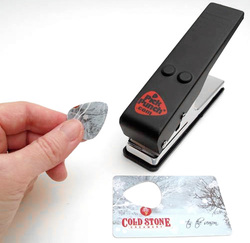 Pick PunchThis one is new to me. I actually just saw this a few minutes ago and thought it was definitely unique enough to mention. You can take any old credit cards, gift cards, etc. and make guitar picks! They also sell sheets of material that you can use to make picks. At $25 this definitely may be worth checking out! (Due to popular demand it is backordered until December 11th.)*If anyone tries this out before I do, please send a review!*
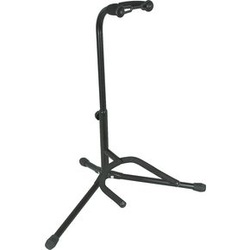 Guitar StandYou can usually pick these up for under $10. If you're guitarist has more than one guitar you can pick up a double or triple guitar stand for a few bucks more. Guitarists that leave their guitars outside of their case and in easy reach (on a guitar stand for instance) are much more likely to grab their guitar and play.
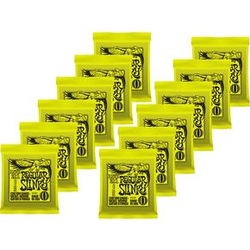 Guitar StringsFor what it's worth, I like Ernie Ball strings. They're cheap and really like the sound and feel of them. You can pick them up for less than $5/pack or you can stock up and buy your guitarist enough for the next few years! These make great stocking stuffers. The average guitar student should be changing strings every semester. I can teach you to change them during a lesson if you bring strings or you can have me or a guitar shop do it for you outside of lessons for around $10.
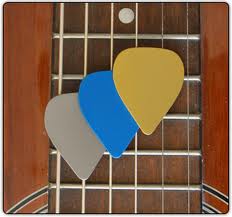 Guitar PicksYou can never have too many guitar picks. They get lost, borrowed, forgotten about....grab a pack or two of picks for your guitarist's stocking and he will thank you later. They normally come in 12 packs in a variety of sizes and materials. If you're not sure what size or material they like peak into their guitar case to see what they use or buy them an assortment. In general, guitar picks come in thin, medium, or heavy (or a measurement that would correspond with it). Most kids are more excited about cool looking picks regardless of the size or material. More experienced guitarists will have a particular brand/size/material that they prefer. I've been using Dunlop Nylon, .60mm for years, but it's too thin for most of my students. Many beginners seem to prefer a heavy pick, but it's all personal preference.
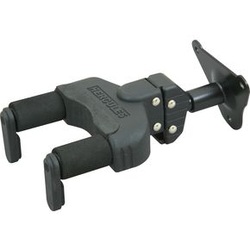 Guitar Wall HangerSame idea as the guitar stand but with a much cooler appeal. I like the Hercules Wall Hanger because the weight of your guitar locks it into place. These run about $15.
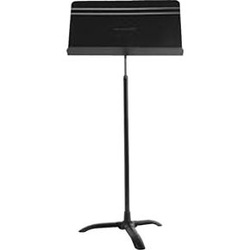 Music StandNot much to say here, but a music stand definitely makes for easier practice. Bypass the metallic wire stands. They're cheaper and easier to transport, but they really don't hold music well. The Manhasset pictured here is the standard and runs about $30.
It’s hard for me to believe that I am already into my third year at Hunter Street and second year at FBC Pelham! Can you believe that our fall semester is already coming to an end? This is officially my longest stretch as a music teacher at any one location. I love it, because I have really gotten to see my students grow and develop. Sometimes I really stand amazed at the talent that sits in front of me and the bright futures that lie ahead for these students. A few quick reminders about practice (these are general rules, and may differ per student):1) Who is responsible for making sure that students practice? - Age 12 and under: The Parent - Age 13 and up: The Student 2) Students should be practicing 10 minutes every day per year that they have been playing the instrument. (10 minutes/day = 1 year, 20 minutes/day = 2 years, etc..). I have students that were great practicers their first year, but never increased practice time as their skill and material advanced. 3) It is not unusual for students to not want to practice. In my experience, many students do not really enjoy playing and practicing until their early teens. Until then, make practice part of their normal daily routine and lay a solid foundation. A great addition this semester has been the launch of my website: www.stickandstrum.weebly.com. It has been steadily building over the last few months and has many great features. You can find links to lesson books and supplies and my teaching calendar in one easy place. This makes it simple to keep up with which week your student is on and any weeks that may not have lessons. Other great features include online lessons, a blog, gear for sale, product reviews, gear buying guides, tips and tricks, links, and more. By the end of the year I’m hoping to have video lessons on the site to help students work on assignments and exercises between lessons. If you are on the lookout for a new instrument, check with me first! I try to keep extra guitars and drums on hand to sell and rent to students. I setup each instrument and make sure that it is in top playing condition and my prices are well below what you would pay for comparable new instruments. I highly recommend buying used gear. There are lots of great deals to be found and correctly setup and maintained instruments will improve with age! On a related note, if your student has upgraded recently and you have old gear (guitars, drums, keyboards, etc) around that you would like to get rid of let me know! I am always on the lookout for solid equipment for students of all experience levels and I really enjoy fixing up and repairing instruments. -shane
Exciting things in the works here at stickandstrum! This week I ordered some drum mics and other recording gear. By the end of the year I'm hoping to have some video lessons posted. I know a lot of people (myself included) are visual learners and sometimes it's just a lot easier to do something when you can see someone else do it. I'm looking forward to being able to post some warmups, guitar licks, strum patterns, drum fills, grooves, etc. Video lessons will serve two main purposes: reinforcing what I teach in lessons to current students and offering instruction and ideas to non-students. Video lessons are something that I have always wanted to be able to offer students. I know how frustrating it is to sit in a lesson and begin to grasp something and then completely forget it when you go home to work on it. This semester especially, I have noticed a few key areas where I think video lessons would really benefit students between lessons: - Strum Patterns: I have quite a few students learning chords and how to strum this semester. It's a lot easier to follow when there is someone guiding you along. It's an entirely different situation when you're at home alone looking at a sheet of paper and trying to figure out what to do!
- Drum Warmups: There are a few warmups and ideas that I've talked about this semester that not all of my students have fully grasped yet. One of these is the Subdivision Warmup. This is another example where it's sometimes just easier to watch and play along.
- Particular songs and exercises: There are plenty of random songs and exercises from the lesson books and elsewhere that I've been working on with students this semester. I'm really looking forward to being able to post videos of these songs to help students out between lessons.
- Chords: Simple videos playing through various basic chords so that you can see and hear them as you work through them at home.
If you aren't a current student, I think that there is still tremendous benefit to watching and learning from videos. Nothing replaces one-on-one instruction with a teacher that can guide and correct you, but the right videos can go a long way to lay a solid foundation. So, until I get some videos up here is a great drum site that I frequent and highly recommend!
I love this site. You will definitely be hearing more from me about Drummer Connection and Billy Ashbough. Billy has some great lessons ranging from beginner to advanced. He's a solid drummer (having played with everyone from *N Sync and Britney Spears to Tim Mcgraw and Gloria Esteban) and a great teacher. I've learned a lot from him and I highly recommend these videos. There are hundreds of videos ranging from drum rudiments, to fills, to setting up your set, to stick twirls. The site also features drumless tracks that you can play along to. Great site.
There are a lot of different expectations when people walk in the door for music lessons. Some are misguided, some are unrealistic, and some are perfect. I've been teaching lessons for quite a few years now and this is a pretty comprehensive look at what to expect and what not to expect when taking music lessons.
1. My job as a teacher is to guide you in learning; to help the student as they learn and practice. Think of me as a mentor and guide. I am not merely a dispenser of information or a magician. I can only work with what you bring me as a student.
2. If your child is under 12 it is your job as a parent to make sure he is practicing.
I understand wanting to teach children responsibility, but until they reach an age where they can really make decisions for themselves it is your responsibility as a parent to make sure that your child is practicing. I use twelve as a general age, but every kid is different. Until around middle school age almost all of my students (even my star students) have to be made to practice. Make it a non-negotiable part of the normal routine, like brushing your teeth. Would you let your kids stop brushing their teeth just because they didn't feel like it?
3. You will get out what you put in. If you practice 30 minutes every day, you can expect a solid, gradual enhancement in your musical ability. If you only practice your instrument a few minutes a week (or only when you see me) then don't expect much in return.
4. I cannot make you a great musician, only you can do that. I can guide you and give you tips to make your practice more efficient. I can give you exercises and songs that will challenge your ability and stretch you as a musician. But only you can put in the work to make something great out of it.
5. Excuses for lack of practice (even great excuses) don't matter. When I ask a lot of students about their practice time during the week the initial responses are generally, "I went to a birthday party this weekend...so I didn't get much practice." "My grandparents were in town...so I didn't get much practice." "My sister had a softball game...so I didn't get much practice", etc. You make time for what you want to do, period. If you don't practice, you will not get better no matter how great your reasons for not practicing were.
6. If you don't practice you will not enjoy lessons or the instrument and you won't be any good at it. This seems like a no-brainer, but I have had students come through that rarely practice and wonder why music lessons aren't any fun and why they aren't improving. Our culture is catering more and more towards instant gratification. If you are looking for instant gratification, music lessons are not the answer. Being able to play an instrument is enriching and rewarding, but it takes a lot of time and effort. Is it worth it? Definitely.
7. If you come to lessons unpracticed all I can do is watch you practice for 30 minutes. This isn't fun for anyone, but you would be surprised at how often it happens. If you haven't practiced, there is nothing I can do except watch you work on what you should have been working on all week. I can't teach anything new. I can't even reinforce old techniques. Without regular practice, everything breaks down. As a general rule, no more than 10 minutes of our lesson time should be dedicated to working on material that has already been covered. I should listen to what you have practiced, give encouragement and correction, and then go on to new material.
8. Practice involves working diligently and productively on a piece of music or exerciese.
Practice is not playing through your favorite songs over and over.
I made this mistake for a long time. Playing your instrument at home is not the same thing as practicing. To be honest, practice time should be about 80% frustration and hard work followed by about 20% of sheer joy and fun. The concept of practice is simple: Take something that you are having trouble with and work on it repeatedly until you become proficient at it. This is the only way to practice. I have had students that "practice" for an hour each week, but only play through fun songs and never work on bettering the assigned material. This goes back to instant gratification. If you only play easy, fun songs during your practice time now you will never be able to play challenging, fun songs later.
9. If you aren't practicing and are strugging with easy material don't expect to work on difficult songs. There is a logical progression to everything. If we aren't working on challenging material, it's because you aren't ready to work on challenging material yet. I'll let you know when you're ready.
10. Practice every day. Learning an instrument is as much about muscle memory as it is learning to read music. As your body adapts to doing certain movement (playing notes on the guitar or grooves on the drums) you will become more proficient at it. Daily practice is the key. You will be a much better musician if you practice six days for ten minutes than if you practice one day for sixty minutes.
11. Have Goals. Have things that you want to achieve. Your goals should be measurable and achievable. Here's some good examples:
"I want to play this song completely without stopping by next week."
"I want to be able to play (insert song here) by the end of this semester"
"I want to be able to play this song without looking at my hands"
12. Taking music lessons for "fun". I have had parents tell me that they just want to make sure that their kids have a great time and that it's all about fun. Many times, these are also the students that don't practice because practice isn't "fun". Learning an instrument can be a lot of fun, but it takes hard work and practice too. I guarantee that your child will not have fun learning an instrument if they never practice because it isn't "fun".
------------------------------------------------------------------------------------------------------------------------
You probably noticed that most of the above were about practice. That is because that most of what is accomplished when learning an instrument is not accomplished in the lesson room. It is accomplished by putting in hard work at home. I struggled for a long time to find good practice habits, but I can assure you that they do pay off! I'm still not as diligent as I need to be with my practicing, but it does make a difference.
I'd love to hear what you think. Feel free to post comments or questions!
The impact that Guitar Hero and Rock Band has had on our current musical state is undeniable. When I first started teaching guitar, I was saddened by the songs that most students wanted to learn. Most of it was whatever bland, pop artist was currently on the radio or rap. There's just not much that a guitar teacher can do within those genres. Enter Guitar Hero. All of a sudden my students want to learn AC/DC, Ozzy, and Boston. Excellent! Now I've got something to work with. Guitar Hero and Rock Band have introduced the current generation to a lot of artists that they would probably have never heard, but will it make you a great guitarist or drummer?
First, lets separate the two and talk about guitar. Sadly, even if you can rock it out on expert on the latest guitar hero, it probably won't help you out very much in the real guitar world. Pushing buttons just isn't the same as having to learn to press down strings. But there are some benefits. It will help you with dual hand coordination. Translation: It may be easier for you to fret a note with your left hand and pick a note with your right hand if you've had some Guitar Hero experience. Depending on the song and your right hand technique (all downstrokes or moving the controller down and up) it may even help with developing more solid rhythm or alternate/sweep picking. So, if I had to rate Guitar Hero's ability to prepare you for the world of actual guitar I would give it about a 3/10, only slightly higher than air guitar.
Now we come to drums. Caveat: I must first admit that I have only had limited experience playing with the drums on Rock Band and haven't had the opportunity to try it on Guitar Hero. That being said, I think that drums on Guitar Hero/Rock band are an adequate preparatory tool for learning drum set. You get the feel of holding sticks and playing with multiple limbs (both hands and your right foot) and it definitely helps with developing a solid rhythmic foundation. While playing drums on Rock Band I had to stop midway through the song and refocus because I caught myself jamming along to the song and playing parts that may not have necessarily been flashing on the screen. The Rock Band drum parts are a very decent replication of what it would feel like to actually play drums. It also gives a feel for staying in a consistent tempo (speed) instead of randomly beating drums in whatever tempo the aspiring drummer may choose. Now for the negative. Although Guitar Hero/Rock Band is a great way to get a feel for drums, it is almost inevitable that bad technique will form that will later have to be broken. Live drums feel and sound different then rubber pads (and are positioned differently), so this will take some adjustment. There is also no Guitar Hero/Rockband provision for your hihat (left foot) technique. But more important is stick grip and hand technique. The "caveman approach" to drumming (manhandling the stick like a club) that Guitar Hero/Rock Band often causes is quite different from the grips and finesse used in modern drumming. To be fair, most students begin drums with this caveman grip whether they have played Guitar Hero/Rock Band or not. Guitar Hero/Rock Band only strengthens a bad technique through repeated exposure. So, if I had to rate Guitar Hero's ability to prepare you for the world of actual drumming I would give it about a 7/10, a noticeable improvement from banging on mom's pots and pans in the kitchen.
It is almost funny to me how many beginner students I have that brag about the level that they can play on Guitar Hero/Rock Band and assume that they will immediately be able to transfer that over to the actual instrument. I think that speaks to our instant gratification culture, but I'll save that for a later blog.
In closing, here are two guys jamming out to arguably the most difficult song on Guitar Hero. Could these guys play this on real instruments? Not sure, but i'm impressed at their video game virtuosity:
So, i settled in on a new design for the site and I think I like this one a lot better. Granted, from observing the traffic to the site most people never saw the old format, but I like the sleek new look. What do you think?
The goal of this website is two-fold. First, I want a place where I can point my students to check out lesson books and other things I may talk about during lessons. Secondly, I want this to become a resource for guitarists and drummers (with a little thrown in here and there about other instruments).
I'm in the process of adding some new features soon including Product Reviews and Instrument Comparisons. Product reviews give me a chance to give feedback on some of the cool products I have had the opportunity to experiment with lately. I've got two product reviews that I'm currently writing that should be finished by the end of the week. I'm also excited about instrument comparisons. I often get questions similar to this, "What's the best drum set I can get?" or "What guitar should I get my beginning student?". The answers to these questions are always quite subjective depending on who you ask, but I'm trying to bring in a little more objectivity. The first instrument comparison will be between drum sets (complete sets and shell packs) and we'll look at wood types, cost, configurations, etc.
Practice. We all have to do it and none of us does it as well as we should. I've been rethinking practice lately and here's a few simple thoughts that I'll expound on in a later blog..
1) Have Goals. If you don't have specific and measurable goals in your practice you are setting yourself up for failure and/or mediocrity. They don't need to be elaborate. Here's a few examples: "I want to be able to play through the entire song without stopping or having to look at my hands", "I want to play through this song at 80bpm", "I want to play all notes correctly", etc.
2) Work on different aspects of your playing. Once you are past the beginner level start to identify different aspects of you're playing that you want to improve on and alternate practices with these. For example, if you are a guitarist working on the lesson book and chords: Divide your time between both! This seems like a simple enough concept but many musicians (myself included!) seem to have tunnel vision when it comes to practice. It's good to work on single aspects of your playing to gain mastery, but make sure that you're not ignoring other parts.
More later...
-shane
Have you ever had your guitar setup properly? When was the last time that you had your strings changed?
Part of being a guitarist is the proper care and setup of your instrument. Guitar students that have 30 minute lessons weekly and practice for 1-2 hours a week should change their strings at least every semester (August and January). The older your strings get, the more grimy and difficult your guitar will be to play.
A basic guitar setup includes setting the action, adjusting the intonation, and cleaning. Lost? It's not as bad as it sounds.
Setting the Action
The "action" refers to how close the strings are to the fretboard. The farther the strings are from the fretboard the harder you'll have to push down to get a good sound. Lowering the action helps guitarists to achieve a better sound with less effort.
Adjusting the Intonation
This step involves getting the guitar in tune with itself throughout the length of the string. While I hope my students are tuning every time that they play (right guys?), setting up the intonation is a little different. Once the guitar is tuned, screws on the saddle (on an electric guitar) are adjusted to make sure that the string stays in tune on every fret, not just the open strings.
Cleaning
At least once a year, I take my guitars apart completely. I clean and polish all of the chrome on the bridge, saddles, tuners, and strap buttons. If it's a rosewood fretboard, I'll add some lemon oil as needed as I clean and degunk the fretboard. Then I polish the guitar body itself. At this stage I also check all of the electronics to make sure the solder joints look good and that everything is working properly.
--------------
So, where does that leave us? EVERY guitar would benefit from a proper setup at least once. After the initial setup, only minor adjustments (if any) will be needed for the life of the instrument. A guitar that is setup well will play better, sound better, and hold it's value better than an instrument that is neglected.
I offer basic setups for electric guitars for $20. I do all of the above (and more) and include a new set of strings. I'll also give you a guitar to use (if you don't have a spare at home) while I'm working on yours. Prices vary widely depending what shop you go to, but you can expect to pay on average $30-$50 + the cost of strings.
I will change your strings for $10 (including the cost of new strings) and clean the guitar and fretboard in the process. But, I would MUCH rather teach you to change your own strings. Bring a set of strings to a lesson and I'll take our normal 30 minute lesson and teach you how to change your own strings.
If you prefer to go to a guitar shop, I can recommend quite a few local shops that I trust to do a great job.
So, here's the bottom line:
1) Get your guitar set up and adjusted at least once.
2) Change your strings at least twice each year.
Keep strumming.
-shane
|









 RSS Feed
RSS Feed